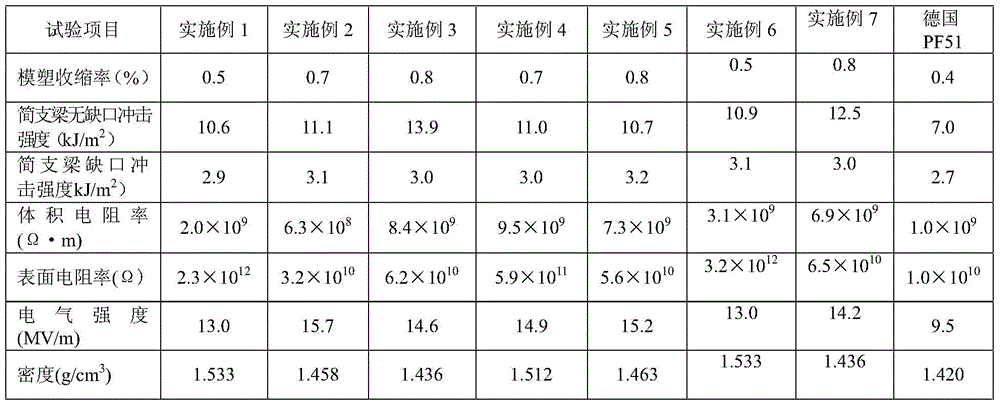Preparation method of cotton fiber reinforced injection phenolic molding compound
A phenolic molding compound and cotton fiber technology, applied in the field of phenolic molding compound, can solve the problems of unsatisfactory mechanical properties and water absorption, and achieve the effects of improving interfacial compatibility, reducing water absorption, and enhancing cohesion.
- Summary
- Abstract
- Description
- Claims
- Application Information
AI Technical Summary
Problems solved by technology
Method used
Image
Examples
Embodiment 1
[0044] 1) Weigh the following components for later use: 100 parts of novolac resin (i.e. thermoplastic phenolic resin, the same below), 13 parts of hexamethylenetetramine, 80 parts of 400-mesh silicon micropowder, and 35 parts of cotton fiber with a length of 2 mm , 5 parts of magnesium hydroxide, 5 parts of calcium stearate, 6 parts of oil-soluble black;
[0045] 2) Take silicon micropowder and a titanate coupling agent equivalent to 1% of its dosage and place it in a ball mill jar for ball milling. Control the speed of the ball mill pot to 50 rpm, and the milling time is 20 minutes;
[0046] 3) Take hexamethylenetetramine and pulverize it to 80 meshes, and then mix it evenly with the surface-treated silicon micropowder and other components;
[0047] 4) put the mixed material into a twin-screw extruder for extrusion, the barrel temperature of the twin-screw extruder is 75-100°C, and the screw rotation speed is 70rpm;
[0048] 5) After the extruded material is cooled to norma...
Embodiment 2
[0056] 1) Weigh the following components for later use: 100 parts of novolac resin, 15 parts of hexamethylenetetramine, 50 parts of 600-mesh calcite, 45 parts of cotton fiber with a length of 3mm, 2 parts of magnesium hydroxide, stearic acid 3 parts of zinc, 4 parts of iron red;
[0057] 2) Put calcite and aluminate coupling agent equivalent to 4% of its dosage in a ball milling tank for ball milling, control the speed of the ball milling tank to 60rpm, and the ball milling time is 100min;
[0058] 3) Take hexamethylenetetramine and pulverize it to 100 meshes, then mix it evenly with surface-treated calcite and other components;
[0059] 4) put the mixed material into a twin-screw extruder for extrusion, the barrel temperature of the twin-screw extruder is 75-95°C, and the screw rotation speed is 90rpm;
[0060] 5) After the extruded material is cooled to normal temperature, it is pulverized into irregular powder with a diameter of 2-5 mm to obtain the cotton fiber-reinforced...
Embodiment 3
[0068] 1) Take the following components by weight percentage for later use: 100 parts of novolac resin, 18 parts of hexamethylenetetramine, 30 parts of calcium carbonate of 300 meshes, 55 parts of cotton fiber with a length of 5 mm, 1 part of calcium oxide, 2 parts stearic acid;
[0069] 2) Take calcium carbonate and a silane coupling agent equivalent to 0.5% of its dosage and place it in a ball milling tank for ball milling, control the rotating speed of the ball milling tank to 10 rpm, and the ball milling time is 120 min;
[0070] 3) take hexamethylenetetramine and pulverize it to 80 meshes, then mix it evenly with surface-treated calcium carbonate and other components;
[0071] 4) put the mixed material into a twin-screw extruder for extrusion, the barrel temperature of the twin-screw extruder is 80-100°C, and the screw rotation speed is 77rpm;
[0072] 5) After the extruded material is cooled to normal temperature, it is pulverized into irregular powders with a diameter ...
PUM
| Property | Measurement | Unit |
|---|---|---|
| length | aaaaa | aaaaa |
| impact strength | aaaaa | aaaaa |
| impact strength | aaaaa | aaaaa |
Abstract
Description
Claims
Application Information
 Login to View More
Login to View More - R&D
- Intellectual Property
- Life Sciences
- Materials
- Tech Scout
- Unparalleled Data Quality
- Higher Quality Content
- 60% Fewer Hallucinations
Browse by: Latest US Patents, China's latest patents, Technical Efficacy Thesaurus, Application Domain, Technology Topic, Popular Technical Reports.
© 2025 PatSnap. All rights reserved.Legal|Privacy policy|Modern Slavery Act Transparency Statement|Sitemap|About US| Contact US: help@patsnap.com



